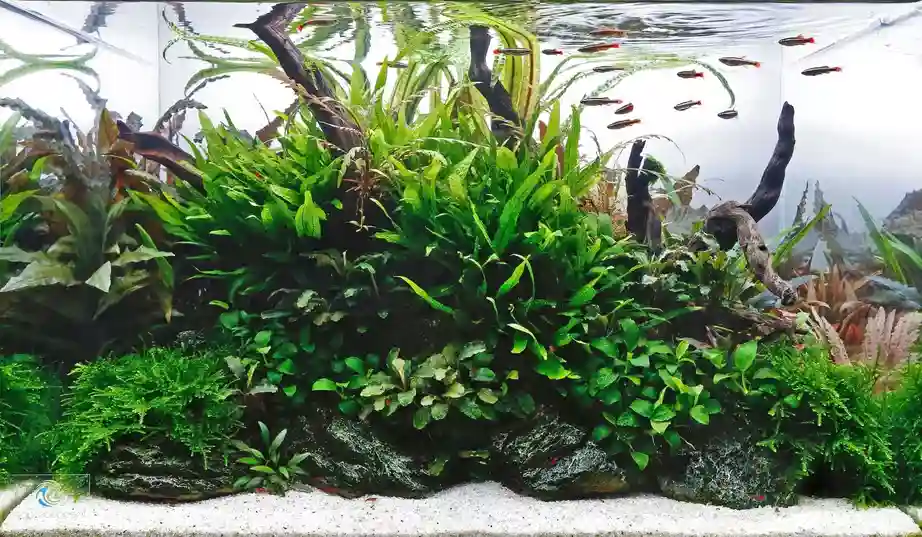If you’re an aquarium enthusiast, you’re likely familiar with the beauty and versatility of java fern. This popular aquatic plant is a hardy and resilient addition to any aquarium, making it a great choice for both beginner and experienced aquarists. However, to ensure your java fern thrives, it’s important to understand how to properly care for it. In this article, we’ll provide you with a complete guide to java fern care, including tips for maintenance and troubleshooting common issues.
Key Takeaways:
- Java fern is a popular and resilient aquatic plant.
- Proper care and maintenance are essential for java fern to thrive in your aquarium.
- Understanding the ideal conditions required for java fern is crucial for ensuring its longevity.
- Regular maintenance and troubleshooting can prevent common issues from damaging your plant.
- Creative aquascaping can enhance the visual appeal of your aquarium using java fern as a focal point.
Understanding Java Fern: An Introduction
Java fern is a beloved plant in the aquarium world due to its hardiness and unique appearance. Native to Southeast Asia, java fern thrives in low-light environments and is an excellent choice for beginners.
The plant’s distinctive fronds have a dark green color and can reach up to 13 inches in length. Java fern is a slow grower, but with patience and proper care, it can become a stunning centerpiece in your aquarium.
When growing java fern in your aquarium, it’s crucial to ensure the conditions are suitable for its growth. Providing moderate to low lighting and maintaining a temperature range of 68-82°F is ideal for its growth. Ensure that your water quality is consistent and well-maintained to keep java fern healthy.
Java Fern Growing Tips:
- Plant java fern in a shaded area of your aquarium to avoid direct light exposure as it can cause the leaves to brown.
- Do not bury the roots of java fern in the substrate. Instead, attach it to rocks or other decorations in your aquarium to allow it to absorb nutrients from the water column.
- Java fern can also be attached to driftwood or left floating on the water’s surface, creating a more natural appearance in your aquarium.
Best Practices for Java Fern Care:
- Regularly monitor the water parameters in your aquarium to keep them within the optimal range for java fern growth.
- Prune java fern regularly to remove dead or damaged leaves, promoting healthy growth.
- Propagate java fern by dividing the rhizome or removing plantlets that develop on the leaves. This keeps the plant healthy, encourages growth, and prevents it from taking over your aquarium.
By following these java fern growing tips and best practices for care, you can ensure your plant thrives in your aquarium. In the next section, we will discuss proper care and maintenance for java fern.

Proper Care and Maintenance for Java Fern
If you want to keep your java fern healthy and thriving, there are a few important things you need to keep in mind. Follow these tips to ensure optimal conditions for your java fern:
Planting or Attaching Java Fern
Java fern can be planted in the substrate or attached to aquarium decorations like driftwood or rocks. If planting, make sure the rhizome (the thick stem that connects the leaves) is not buried in the substrate, as this can lead to rotting and eventual death. Instead, tuck the roots into the substrate while leaving the rhizome exposed.
If attaching to decorations, use cotton thread or fishing line to tie the rhizome securely in place. Over time, the roots will attach themselves to the decoration.
Monitoring Water Parameters
Java fern prefers slightly acidic to neutral water conditions, with a pH range of 6.0-7.5. The water temperature should be between 68-82°F. Keep an eye on ammonia, nitrite, and nitrate levels, as high levels can harm your java fern. Regular water changes can help maintain optimal water parameters.
Managing Algae Growth
While java fern may be resistant to some types of algae, it can still become overrun if conditions are not right. To prevent algae growth, ensure proper lighting and avoid overfeeding. Use an algae scraper or brush to remove any excess algae from the leaves.
Pruning and Propagating Java Fern
To promote healthy growth and prevent overcrowding, prune any damaged or discolored leaves regularly. You can also propagate java fern by splitting the rhizome and attaching the new plant to a different decoration. This will not only encourage growth but also help fill out your aquarium.
With these tips in mind, you can master the art of java fern care and enjoy a beautiful and healthy plant in your aquarium.
Troubleshooting Common Java Fern Issues
Despite your best efforts, your java fern may encounter a variety of issues that can impede its growth and overall health. Here are some common problems and tips for resolving them:
Yellowing Leaves
If you notice yellowing leaves on your java fern, this could be a sign of nutrient deficiencies or poor water quality. Ensure that your tank’s water parameters stay within the ideal range and consider supplementing with plant-specific fertilizers. Also, check that your java fern is not receiving too much direct light, as this can cause burnt or yellow leaves.
Slow Growth
If your java fern seems to be growing slowly or not at all, check that it is receiving adequate nutrients and light. Consider adjusting the plant’s location or adding a supplemental light source to promote healthy growth. Additionally, java fern can benefit from the presence of carbon dioxide in the water, which can be achieved through the use of a CO2 system.
Black Spots
Black spots on your java fern could be a sign of a bacterial or fungal infection. Remove any affected leaves immediately and consider treating the plant with a plant-safe antimicrobial solution. Ensure that your tank’s water quality is within the ideal range and avoid overcrowding, which can promote the spread of disease.
By addressing these common issues in a timely manner, you can help your java fern thrive and contribute to a healthy and attractive aquarium environment.
Enhancing Your Aquarium with Java Fern
Aside from its functional benefits, java fern can also be a beautiful addition to your aquarium. Its unique shape and vibrant green color add visual interest to any aquatic environment. There are several ways to enhance your aquarium with java fern:
Pairing with Complementary Tank Mates
Java fern is a peaceful plant and makes an excellent companion for many fish species, such as tetras, guppies, and corydoras. Its low maintenance needs make it an ideal choice for beginners and experienced aquarists alike.
Creating a Focal Point with Aquascaping
Java fern is a versatile plant that can be used to create a variety of aquascaping designs. It can be attached to rock or driftwood to create a natural-looking focal point. Alternatively, you can plant it in the foreground or background of your aquarium, depending on your preference.
Designing a Balanced Aquatic Environment
By adding java fern to your aquarium, you’ll also be improving the overall health of your aquatic environment. Its ability to absorb excess nutrients and inhibit algae growth helps to maintain a balanced ecosystem. With proper care and maintenance, your java fern will flourish and add beauty to your aquarium for years to come.
Using these tips, you can create a unique and visually appealing aquatic environment while caring for your java fern. Refer back to this java fern care guide to ensure that your plant stays healthy and vibrant in your aquarium.













Comments are closed.